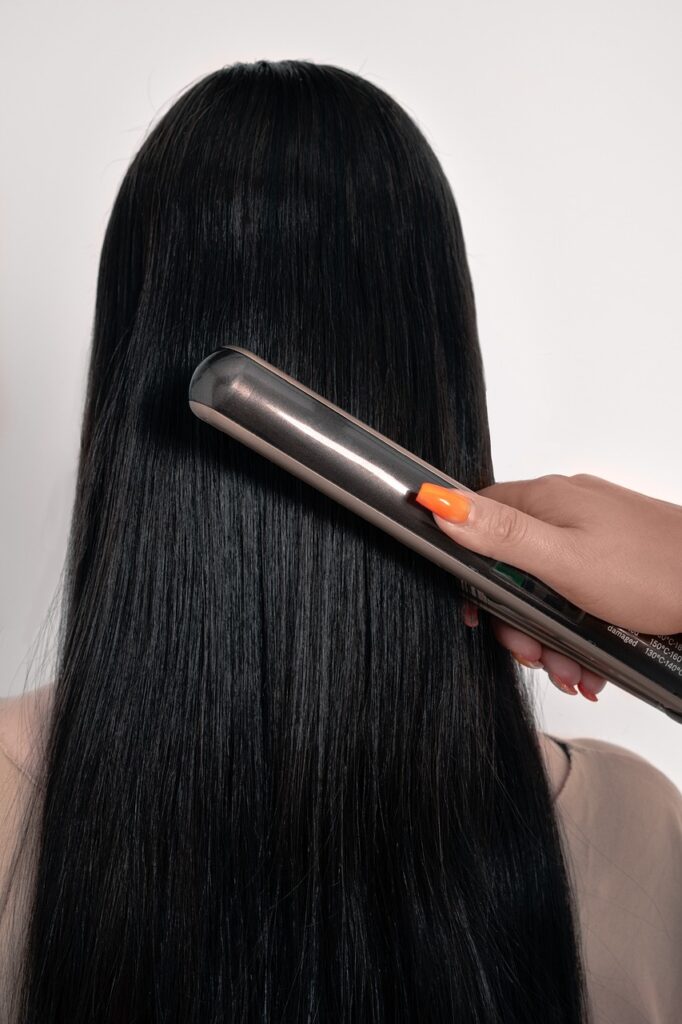Chemical hair straighteners, also known as hair relaxers, are transformative treatments designed to permanently straighten curly or wavy hair.
These products utilize powerful chemicals, such as sodium hydroxide or ammonium thioglycolate. These chemicals break down the hair’s protein structure and reshape it into a sleek, straight form.
Although chemical hair straighteners offer a long-lasting solution for those seeking a permanent straightened look, they require careful consideration. Proper application is required to minimize potential damage to the hair and scalp.
If precautions are neglected, they can lead to dryness, scalp irritation, breakage, and hair loss. Excessive and ignorant use can also increase the risk of developing reproductive cancer.
Since late 2022, many women have started taking legal action against the manufacturing companies. They have been at a high risk of developing reproductive cancers. The hair straightener cancer lawsuit has been filed by various women around the globe.
Let us look at some insights into the lawsuit and the dangers surrounding hair relaxers and straighteners.
History of Hair Straighteners
Hair straighteners have come a long way in the beauty industry. They have been in popular demand, especially among black women due to their natural curly texture of hair.
Since the 1980s and 1990s, hair straighteners have been in huge demand to achieve straight hair as a more permanent solution. Influenced by beauty standards, many women started using the product from a very young age.
This became a cultural practice among the black women. However, it comes with its consequences. As it contains harsh chemicals like sodium hydroxide and formaldehyde, the straightener brings along adverse health effects.
Concerning Effects of Hair Straighteners
The National Library of Medicine published a study in the journal of the National Cancer Institute. It stated that women using the product more than 4 times a year develop a double high risk of uterine cancer.
They have found a link between hair straighteners and the risk of developing breast cancer, uterine cancer, and endometrial cancer.
They examined 33947 women aged between 35-74 for around 10.9 years. In addition to uterine cancer, chemical straighteners have also been linked to a higher risk of endometriosis and uterine fibroids.

Another research was done where racial disparities could be seen in rates of uterine cancer.
Kimberly Bertrand, the lead author, pointed out that Black women have a higher frequency of aggressive subtypes. This research, published on Science Direct, discovered a significant increase in cancer risks among postmenopausal women who often used hair relaxers.
Hair Straightener Cancer Lawsuits
Companies like Strength of Nature, L’oreal, and Soft Sheen are being sued for marketing such hazardous products. A total of 8,788 cases have been filed as of May 2024. The lawsuits have been converted into multidistrict litigation in the U.S. Court of the Northern District of Illinois.
According to TorHoerman Law, the litigation is still growing, with 8,468 lawsuits still pending in the multidistrict litigation. The MDL structure is being utilized to aggregate these litigations for efficiency.
They are aiming towards centralizing pretrial hearings, streamlining discovery, reducing redundant efforts, and ensuring consistent legal outcomes in related cases.
As they are product liability class action lawsuits, a global settlement is expected to resolve. Although based on a tier system, the compensation may range from $10,000 to $1 million. Higher-tier plaintiffs would receive more than the lower-tier plaintiffs.
Frequently Asked Questions (FAQs)
How long does a chemical hair straightener last?
The effects of a chemical hair straightener are typically permanent until new hair growth occurs. The treated hair will remain straightened until it naturally grows out, and the new hair growth will have the original texture. The frequency of touch-ups or reapplication depends on the individual’s hair growth rate, usually ranging from every 6 to 12 weeks.
Can I use a chemical hair straightener on colored or damaged hair?
It is generally not recommended to use a chemical hair straightener on colored or severely damaged hair. Chemical treatments can further weaken already compromised hair, leading to increased breakage and a loss of elasticity. It’s advisable to consult with a professional stylist who can assess the condition of your hair and provide appropriate recommendations.
How should I care for my hair after using a chemical hair straightener?
After using a chemical hair straightener, it’s crucial to follow a proper hair care routine to maintain the health and integrity of your hair.

This includes using sulfate-free and moisturizing shampoos and conditioners, applying deep conditioning treatments regularly, minimizing heat styling, and protecting the hair from excessive sun exposure or chlorine.
Can I reverse the effects of a chemical hair straightener?
The effects of a chemical hair straightener are permanent until new hair growth occurs. However, it is not possible to reverse the effects on the treated hair. If you want to return to your natural hair texture, you will need to allow the chemically treated hair to grow out and gradually trim off the straightened portions.
While these treatments offer long-lasting results, it is essential to approach them with caution. Remember to make informed decisions based on your hair type, texture, and overall health.
Proper application, adherence to instructions, and regular maintenance are key to minimizing the potential risks associated with chemical hair straighteners.
Taking the necessary precautions will help you achieve the desired results while keeping your hair looking and feeling its best.
